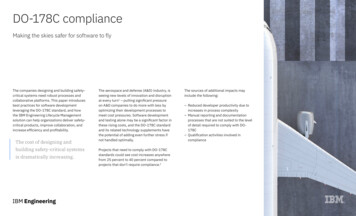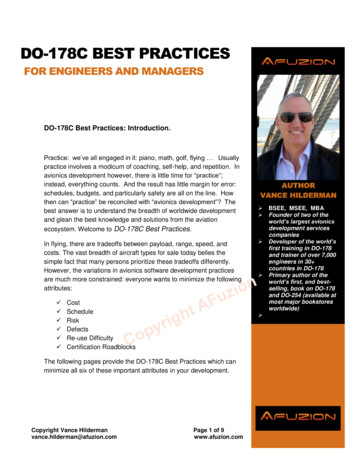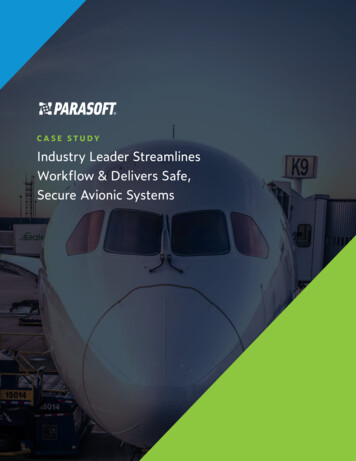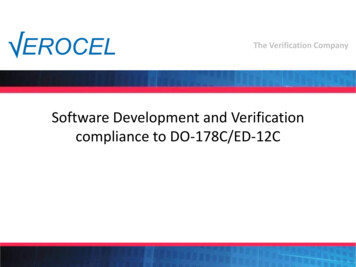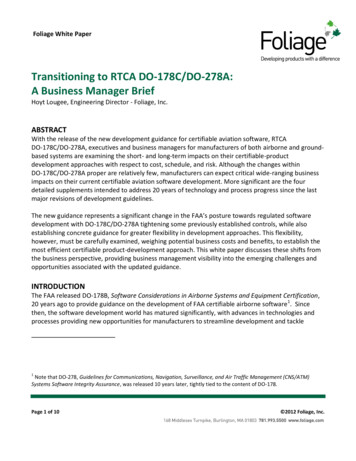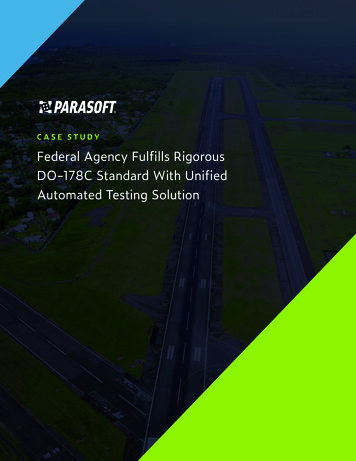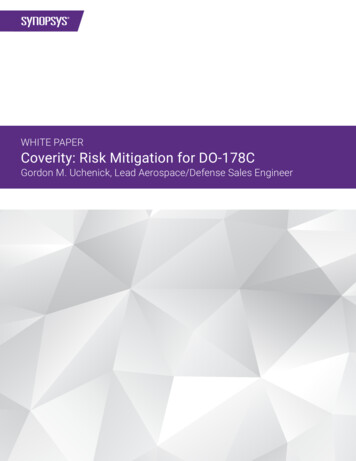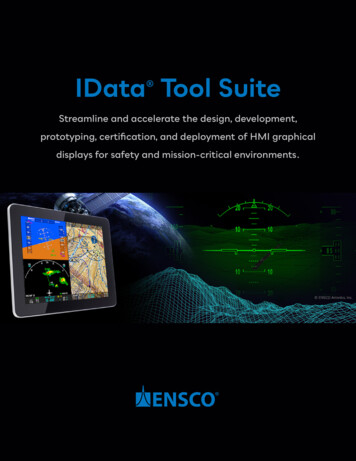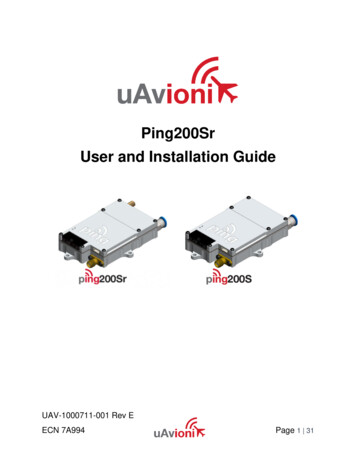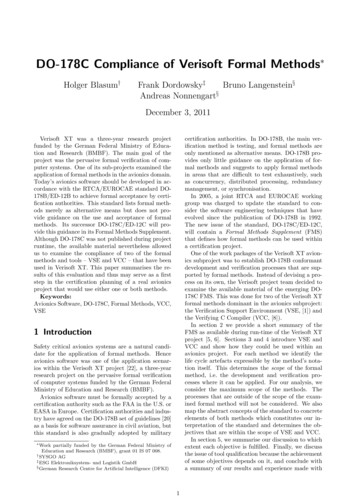
Transcription
DO-178C Compliance of Verisoft Formal Methods Holger Blasum†Frank Dordowsky‡Bruno Langenstein§Andreas Nonnengart§December 3, 2011Verisoft XT was a three-year research projectfunded by the German Federal Ministry of Education and Research (BMBF). The main goal of theproject was the pervasive formal verification of computer systems. One of its sub-projects examined theapplication of formal methods in the avionics domain.Today’s avionics software should be developed in accordance with the RTCA/EUROCAE standard DO178B/ED-12B to achieve formal acceptance by certification authorities. This standard lists formal methods merely as alternative means but does not provide guidance on the use and acceptance of formalmethods. Its successor DO-178C/ED-12C will provide this guidance in its Formal Methods Supplement.Although DO-178C was not published during projectruntime, the available material nevertheless allowedus to examine the compliance of two of the formalmethods and tools – VSE and VCC – that have beenused in Verisoft XT. This paper summarises the results of this evaluation and thus may serve as a firststep in the certification planning of a real avionicsproject that would use either one or both methods.Keywords:Avionics Software, DO-178C, Formal Methods, VCC,VSEcertification authorities. In DO-178B, the main verification method is testing, and formal methods areonly mentioned as alternative means. DO-178B provides only little guidance on the application of formal methods and suggests to apply formal methodsin areas that are difficult to test exhaustively, suchas concurrency, distributed processing, redundancymanagement, or synchronisation.In 2005, a joint RTCA and EUROCAE workinggroup was charged to update the standard to consider the software engineering techniques that haveevolved since the publication of DO-178B in 1992.The new issue of the standard, DO-178C/ED-12C,will contain a Formal Methods Supplement (FMS)that defines how formal methods can be used withina certification project.One of the work packages of the Verisoft XT avionics subproject was to establish DO-178B conformantdevelopment and verification processes that are supported by formal methods. Instead of devising a process on its own, the Verisoft project team decided toexamine the available material of the emerging DO178C FMS. This was done for two of the Verisoft XTformal methods dominant in the avionics subproject:the Verification Support Environment (VSE, [1]) andthe Verifying C Compiler (VCC, [8]).In section 2 we provide a short summary of theFMS as available during run-time of the Verisoft XTproject [5, 6]. Sections 3 and 4 introduce VSE andVCC and show how they could be used within anavionics project. For each method we identify thelife cycle artefacts expressible by the method’s notation itself. This determines the scope of the formalmethod, i.e. the development and verification processes where it can be applied. For our analysis, weconsider the maximum scope of the methods. Theprocesses that are outside of the scope of the examined formal method will not be considered. We alsomap the abstract concepts of the standard to concreteelements of both methods which constitutes our interpretation of the standard and determines the objectives that are within the scope of VSE and VCC.In section 5, we summarise our discussion to whichextent each objective is fulfilled. Finally, we discussthe issue of tool qualification because the achievementof some objectives depends on it, and conclude witha summary of our results and experience made with1 IntroductionSafety critical avionics systems are a natural candidate for the application of formal methods. Henceavionics software was one of the application scenarios within the Verisoft XT project [22], a three-yearresearch project on the pervasive formal verificationof computer systems funded by the German FederalMinistry of Education and Research (BMBF).Avionics software must be formally accepted by acertification authority such as the FAA in the U.S. orEASA in Europe. Certification authorities and industry have agreed on the DO-178B set of guidelines [20]as a basis for software assurance in civil aviation, butthis standard is also gradually adopted by military Workpartially funded by the German Federal Ministry ofEducation and Research (BMBF), grant 01 IS 07 008.† SYSGO AG‡ ESG Elektroniksystem- und Logistik GmbH§ German Research Centre for Artificial Intelligence (DFKI)1
the adoption of the DO-178C.This paper does not attempt to compare VSE withVCC nor both methods with other existing formalmethods. Instead, it summarises the arguments thatmust be provided to the certification authority whenproposing the application of either method in a realproject. Moreover, the paper also identifies the shortcomings of both methods with respect to the DO178C objectives – these non-compliances must be resolved by other means.A formal analysis case is the analogon to a test caseand is a combination of the property to be analysedor proved along with all assumptions relied upon forthe formal analysis. Sometimes assumptions must bemade on the software or its environment in order tosuccessfully complete the formal analysis.A formal analysis procedure is the process of executing a formal analysis case to determine the resultsof the formal analysis and to compare these resultsagainst the expected results. The formal analysis result is the result of an execution of a formal analysisprocedure.The FMS provides guidelines on how formal methods can be used for the verification of the objectivesshown in Fig. 1. In addition to the core document,it defines objectives that concern the usage of formalmethods:2 DO-178C and the FormalMethods Supplement2.1 DO-178BDO-178B lists a total of 20 life cycle data items –artefacts created during the software life cycle. Ofthese 20, only the following are relevant to our discussion: (1) High-Level Requirements (HLR), created inthe software requirements process, (2) Low-Level Requirements (LLR) and (3) Software Architecture, created in the software design process, (4) Source Code,developed in the software coding process, and finally(5) Executable Object Code that is the output of thesoftware integration process.These life cycle data are shown as hexagons inFig. 1. It also shows system requirements as an inputinto the software development process.DO-178B lists a set of objectives that must beachieved by an avionics software project where thenumber of objectives that are applicable to theproject depends on the criticality level of the application. The objectives are related to existence andproperties of the life cycle data (e.g. accuracy, consistency, verifiability) or to the relation between lifecycle data (compliance, traceability). These objectives have been taken over from DO-178B into thecore section of DO-178C and will therefore be referredto as core objectives in the following.Moreover, Fig. 1 shows all activities that are relevant to the examination of the formal methods asarrows and objectives as labels to those arrows. According to the introduction of the DO-178C core document, activities provide a means for satisfying objectives. Correctness of Formal Analysis Cases and Procedures: The formal analysis covers the objectivesshown in Fig. 1. Moreover, any assumptions thatwere included in the formal analysis should bejustified and any false assumptions (which wouldinvalidate the analysis) should be identified andremoved. Correctness of Formal Analysis Results: The formal analysis results are correct and discrepancies between actual and expected results are explained. Correctness of Requirement Formalisation: Incase a natural language requirement is translatedinto a formal notation it must be demonstratedthat the formalisation is a conservative representation of the informal requirement. Formal Method Soundness: A sound methodnever asserts that a property is true when it maynot be true. All notations used for formal analysis shall have a precise, unambiguous, mathematically defined syntax and semantics.DO-178B also introduces a set of objectives thatconsider the verification of the outputs of the verification process. These objectives include the testcoverage of the requirements (requirements coverage)as well as the test coverage of the software structure(structural coverage). The FMS attempts to transferthese criteria to formal methods [5]:2.2 DO-178C and FMS Requirements Coverage: Assurance that there isat least one formal analysis case for every requirement, and that all assumptions about thesoftware and its environment have been justifiedand verified.The DO-178C Formal Methods Supplement (FMS)augments the objectives established in the core document. It introduces general concepts to accommodatea wide variety of different formal methods. A formalmethod is a formal analysis carried out on a formalmodel. A method is accepted as formal if it has anunambiguous, mathematically defined, syntax and semantics [5]. The formal model formulates propertiesconsisting of certain software life cycle data, such asrequirements. Complete Coverage of Each Requirement:Demonstration that all possible paths throughthe code with all possible data values have beenconsidered, and that all assumptions have beenmade explicit and have been verified.2
Figure 1: Development Artefacts, Verification Activities and Objectives, taken from [5] Completeness of the Set of Requirements: Assurance that the set of requirements is completewith respect to the intended functions, i.e. thatthe output is specified for all possible input conditions and that required input conditions arespecified for all possible outputs.level specifications down to the code level. It providesboth an administration system to manage structuredformal specifications and a deductive component tomaintain correctness on the various abstraction levels (see Fig. 2). Taken together these componentsguarantee the overall correctness of the complete development. VSE has been developed on behalf of theGerman Federal Office of Information Security (BSI)to satisfy the needs in software developments according to the standards ITSEC and Common Criteria.Deployments of VSE span several industrial and research projects, among others the control system ofa heavy robot facility, the control system of a stormsurge barrier, a formal security policy model conforming to the German signature law and protocols forchip card based biometric identification [1, 7, 14, 16]. Unintended Dataflow Detection: Demonstrationthat all dependencies between inputs and outputs in the source code comply with the requirements. Dead Code and Deactivated Code Detection:Dead code is executable object code which cannot be executed in an operational configurationof the target computer and which is not traceableto a system or software requirement [20]. Deadcode should be identified by review or analysisand removed.Method. VSE supports development of a structured formal specification, which is organised arounda development graph consisting of development objects (elementary specifications like theories, modulesetc.) and links between them. Specifications are either in the style of Abstract Data Types (ADT) usingpredicate logic or State Based Systems using Temporal Logic of Actions (TLA).For deactivated code, i.e. code that is only executed in certain configurations of the target computer environment, the operational configurationneeded for normal execution of this code shouldbe established and additional verification casesand procedures must be developed to show thatthis code cannot be inadvertently executed.User Interaction. Large specifications are brokendown into smaller parts. The means of structuringspecifications (visualised by links in the graph) arethe following: For sequential systems ADTs can beparametrised, instantiated and enriched. State basedspecifications can be combined to describe concurrent3 DO-178C Scope of VSEThe V erification S upport E nvironment (VSE) is atool that supports the formal development of complex large scale software systems from abstract high3
Specification ComponentsatisfiesVSE in FMS Terms. Fig. 3 shows the life cycle datathat can be expressed with VSE notation in greycoloured hexagons. VSE can be used to even capture system requirements (for an example see [14]).System Requirements, High-Level and Low-Level Requirements as well as the Software Architecture canbe described as ADT or TLA specifications. Fromthe abstract programs VSE can produce source code.Deductive ComponentAxiomsrefinement A property can be any statement that can beexpressed in first order logic or temporal logic.The properties of a system can be collected ina development object and connected to the system specification with a satisfies link. A correct refinement of the system specification wouldthen automatically be a correct refinement of theproperties, if the proof obligations of the satisfieslink can be proved.Proof StaterefinementTheorem ProverProof ObligationsDevelopment GraphVSE-GUIAPIProver-GUIFigure 2: Architecture of VSE The formal analysis cases are the proof obligations generated by VSE on refinement and satisfies links. Deduction units encapsulate data relevant for the proofs – they form a representationof the formal analysis cases within VSE.systems consisting of components described as separate specifications.Furthermore, development objects can be addedto introduce further properties (requirements) of another development object block. A satisfies link between both objects indicates the relationship and isassociated with a deduction unit. Logically the requirements have to be derivable from the systemmodel. A deduction unit hosts the proof obligationsthat are sufficient to show the claim made by the link,and a context with the theories containing the axiomsand lemmas that can be used in the proof.A typical development process starts with a (structured) formal description of the system model on ahigh abstraction level. In a refinement process theabstract system model can be related to more concrete models. This is in correspondence with a software development that starts from a high level designand then descends to the lower software layers suchthat in a sense higher layers are implemented basedon lower layers. Each such step can be reflected by arefinement step in VSE. These steps involve programming notions in the form of abstract implementations,that can later be exploited to generate source code.Each refinement step gives rise to proof obligationsshowing the correctness of the implementations. VSEmaintains a deduction unit for each refinement step.Refinements also can be used to prove consistency ofspecifications, because they describe a way how toconstruct a model.VSE includes a code generator that can produceC code from the abstract programs in a refinementor state based specification. This component of VSEcan be seen as a translation process similar to whatis done in conventional programming language tools.Therefore, application of this component within aDO-178C project should also follow the guidanceoffered by the “Model Based Design Supplement”.However, for simplicity, we have not considered thatsupplement – where source code generation is usedthis will be stated clearly. A formal analysis procedure is represented inVSE by an interactive proof of the generatedproof obligations. VSE attempts to automatically prove the theorems but may require supportby the user. VSE presents the current proof stateto the user, and the user can choose the next ruleto be applied or change the heuristics so that thesystem can complete the proof. Deduction unitsstore partial and completed proofs. Formal analysis results are partial or completedproofs stored in deduction units. All assumptions that are used in a VSE proofneed to be specified in the VSE system. Assumptions are therefore part of the VSE developmentgraph. In order to distinguish assumptions fromrequirements for review they can be separatedinto specific deduction units reserved for assumptions.4 DO-178C Scope of VCCMicrosoft Research’s VCC [18] is a tool that can beused to verify that existing code conforms to requirements. The workflow starting with “code” it suggests conceptually therefore is “opposite” to VSE ofthe previous section 3. The largest piece of softwareverified by VCC has been Microsoft’s Hyper-V [17].Method. VCC belongs to a class of code verification tools (other examples are Caveat, Frama-C,KeY, SPARKAda, VeriFast) that apply backwardreasoning to calculate program properties: for eachstatement of a program, given a logical propositionthat holds after the statement (“postcondition”) anda certain rule set, it is possible to calculate the least4
Figure 3: Scope of VSEpowerful proposition that has to hold before the statement as a first-order formula (“weakest precondition”, WP [12]). It is checked whether the specification implies the WP (“verification condition”). Ifso, the implementation satisfies the specification.(“ghost state”) useful for modelling low-level hardware or high-level properties of the system.VCC in FMS Terms. When used to verify low-levelrequirements expressed as annotations co-locatedwith functions of the source code (typical usage,Fig. 4), VCC has a smaller scope than VSE.User Interaction. The user interface is much simpler than VSE’s. The engineer writes code annotations corresponding to LLRs to the code’s functions(in first-order logic) and pushes the button “verify”.After a tool run there are three possible outcomes:(a) verification is successful, (b) the tool can find acounter-example, (c) time-out: the tool cannot showcompliance in reasonable time.In case of (a) the result can be double-checked todetect contradictions in a precondition of a function.This feature called “smoke check” is very useful inpractice, but at most a heuristic. In case of (b) theverification engineer can inspect the counter-examplevia the tool’s model viewer. Counter-examples indicate that either the annotations are wrong (this is thetypical case) or that they are too weak for the automated proof search. In case of (b) or (c) the task is torefine the auxiliary annotation in a subsequent iteration. However, to test whether a first-order logic formula holds in general is only semi-decidable. In practice this means that only for very simple functionsit suffices to formulate just the pre- and postconditions. In all other cases, the engineer has to providefurther auxiliary annotations to assert that certainproperties hold at certain intermediate points so thatthe automatic inference engine is guided along theway. Annotations also can define specification state The properties typically verified with VCC arelow-level requirements. A formal analysis case is implementation code,its VCC annotations, and the parameters VCCis invoked with. A formal analysis procedure in VCC is the automatic generation of verification conditions andthe subsequent invocation of the theorem proverto prove these conditions. The formal analysis result is the result reportedby VCC after testing whether the proof attemptis accepted, as described above. Assumptions, if possible to be formalised by firstorder logic, can be expressed with the requiresannotation.5 DO-178C Compliance of VSEand VCCThe goal of this analysis is to examine how far themeans of both methods and their tools can contributeto the demonstration of compliance to the objectives.5
Figure 4: Scope of VCCOn the other hand, the current code generator of VSEproduces code that includes elements that are considered hard to verify, such as recursion for example.In order to demonstrate accuracy and consistencyfor source code, DO-178C requires to consider properties such as stack and memory usage, worst caseexecution times, fixed point arithmetic overflow, etc.It may be possible to express some of these with formal notations of VSE and VCC, but other propertiesare just out of scope of the method, so that accuracyand consistency of source code can only partially befulfilled by both methods.VSE fully ensures the conformance to standards ofthe source code because it generates the code. ForVCC, conformance to standards of the manually written source code must be checked with code reviews,but the tool assists with checking for some commonprogramming errors.Target computer compatibility is covered only partially as far as it is possible to express properties ofthe target environment with the formal notations ofthe methods. An example of modelling hardware inVCC (interrupt vector modelled by ghost state) is [2].Traceability is only partially covered by both methods: Neither method provides any means to capturereferences to the informal requirements from whichthe formal requirements have been developed. Itwould be useful to enhance the tools in that respect.On the other hand, traceability between specificationsand source code is fully covered – for VCC because thelow-level requirements are co-located with the sourcecode as annotations, and for VSE because the sourcecode is generated. However, the code generator mustbe formally verified or qualified to support this argument, see section 6. The traceability between specifications that represent requirements or the softwarearchitecture is an interesting issue: natural languageIn a certification project, this analysis is documented,objective by objective, in the planning documents andthen agreed with the certification authority. Similarly, for each method we collected answers to guidance questions derived from each objective, but dueto lack of space, we only can summarise this discussion in the following subsections.5.1 Coverage of the Core ObjectivesFigures 3 and 4 display the results of our analysison the core objectives for VSE and VCC respectivelywhere the objectives have been tagged with the degreeto which the method can support the demonstrationof compliance: fully covered (f), partially covered (p),or not covered (n). We rate an objective as fully covered by the method if it can be assured by means ofthe method alone.The objective is partially covered, if additional verification methods are necessary to show compliancewith the objective, for example, by providing additional paper-and-pencil meta-arguments that cannotbe formulated within the methods formalism.An objective is considered as being not covered bythe method if it cannot be assured by the means ofthat method at all; alternative verification methodssuch as testing must be applied instead.For the specifications, there is full coverage of theobjectives compliance, accuracy, consistency, verifiability, standards conformance, algorithm accuracy,and software architecture compatibility (VSE only),since this is the genuine strength of formal methods.There is a fundamental difference between VSE andVCC with respect to source code: VSE generates it,whereas VCC operates on manually written sourcecode. VCC complains if it is not able to verify thecode and therefore ensures source code verifiability.6
requirements are often represented as a set of individual ‘shall’ statements which allows contemporary requirement management tools to manage traceabilityas a relation between these ‘shall’ statements. This isdifferent for VSE, because currently the user cannotget a comprehensive output showing which axiomsfrom a certain theory are necessary to establish thevalidity of a certain formula. With a coarser granularity, the development graph that displays refinement links between deduction units could be used asa means of showing traceability. It is also possible todisplay, for a proved lemma (that includes the proofobligations), the list of all lemmas and axioms thatare used in the proof. Certification authorities andapplicants must agree on a coarser interpretation oftraceability that is suitable to formal methods suchas VSE, and it is likely that additional guidance mustbe developed on this topic.Partitioning integrity is difficult to assure by testing alone, so formal methods were considered ascandidate for proper assurance early on [21]. Inthe Verisoft project, both VSE and VCC have beenused to prove partitioning properties: for VSE, weadapted the approach of [13] to describe partitioning in PikeOS, and VCC has been used to verify certain spatial partitioning properties of the PikeOS kernel [3].Robustness as well as compliance with high-leveland low-level requirements are verification objectivesof the executable object code in relation to high-leveland low-level requirements. An accepted way to formally verify such properties is to establish propertypreservation between source and object code and thento verify the properties for the source code. However, since the executable object code is not withinthe scope of VSE and VCC, there are no means provided by these methods to show property preservation. Therefore, within the context of both VSE andVCC, robustness as well as compliance of object codeto high-level and low level requirements, can only beverified traditionally with testing.Completeness and correctness of the output of theintegration process is not within the scope of VSE andVCC and must therefore be assured by other means.tutes the soundness of the formal methods, see below. The correctness of theorem provers is discussedin the context of tool qualification in section 6. Theproof procedure itself is standardised and repeatablein both tools.Formal Method Soundness. The concept of proofsin VSE relies on a very small set of basic rules thatin turn are based on well known calculi. They havebeen shown to be sound, and the proof obligationsgenerated by VSE have shown to be sufficient [19].VCC’s specification language is quite rich to covermost of the semantics of the C language. The fulljustification of its soundness is still work-in-progress,so at the time of writing we have rated its soundness as “partial”. The fact that soundness of corelanguage parts [8, 9] and the memory model [10] hasbeen demonstrated as well as our experience with thetool gives us optimism that these efforts will be completed.Correctness of Requirement Formalisation. Thisobjective is concerned with the transition from informal statements to formal requirements. It can only beassured by review, independent of the formal method.5.3 Coverage of Verification ofVerification ObjectivesTable 2 summarises the coverage of VSE and VCCon verification of verification objectives.Requirements Coverage. All requirements are formulated in the notation of the formal methods. Thetools generate the formal analysis cases as proof obligations on the complete set of requirements. Therefore, each tool assures completeness of requirementscoverage.Complete Coverage of Each Requirement. Proofsgenerated by VSE cover all paths through the abstract code that is a refinement from the specifications. The generated source code is a one-to-one mapping between abstract programs and generated sourcecode so that there is a corresponding path throughthe abstract program specification. Proofs generatedby VCC also cover all paths through the source code.For both tools, the proofs are generated by an automated theorem prover so all assumptions must bemade explicit – this is an advantage of the automaticprover over a human prover. However, justification ofthe assumptions must be verified by manual review.Unlike the FMS’s unit proof example where thereare simply no assumptions, in the verification of reactive systems assumptions often are of the form ofglobal invariants. In VCC formal analysis cases forexample, these global invariants are expressed as “requires” clauses, such as the global invariants in [3,Fig. 3] – their justification is manual [3, Sect. 3].Completeness of the Set of Requirements. Theweakest interpretation of this objective is a syntacticcheck that all input and all output variables of theprogram are indeed included in at least one formalstatement. There is no tool support by either VSE or5.2 Coverage of Objectives specific toFormal MethodsTable 1 summarises the tools’ coverage of objectivesspecific to formal methods.Correctness of Formal Analysis Cases, Proceduresand Results. VSE and VCC both check the formal analysis cases automatically, in VSE as proofobligations, in VCC as verification conditions. Thecorrectness of the proof obligations and verificationconditions does not depend on an error prone manual process but on the correct implementation of thetools instead. The subsequent proofs and results depend on the correctness of the underlying calculusand the correctness of the implementation of the theorem provers. The correctness of the calculus consti-7
Table 1: Coverage of Objectives specific to Formal MethodsCoverageDO-178C ObjectiveVSE VCCCorrectness of Formal Analysis Cases and Procedures fullfullCorrectness of Formal Analysis ResultsfullfullCorrectness of Requirement FormalisationnonoFormal Method SoundnessfullpartialTable 2: Coverage of Verification of Verification ObjectivesCoverageDO-178C ObjectiveVSEVCCRequirements CoveragefullfullComplete Coverage of Each Requirement fullfullCompleteness of the Set of Requirements partial partialUnintended Dataflow DetectionnonoDead Code DetectionnonoDeactivated Code Detectionfullfullthe specification holds. In particular this is the casefor VCC, where pointers can be used. Where this follows from properties of the system proved elsewhere,it is reasonable to assume that these pointers are validand the structures they reference are well formed.In a VSE state based specification, it may happen,that you can show that some states are not reachablefrom the initial state. Then it would not be necessary to specify the behaviour of the system in theseunreachable states.Unintended Dataflow Detection. Both methodsand their tools do not provide a dataflow analysiscapability, so that this objective must be ensured byother means.Dead Code Detection. It is not possible to detectdead code w
comings of both methods with respect to the DO-178C objectives { these non-compliances must be re-solved by other means. 2 DO-178C and the Formal Methods Supplement 2.1 DO-178B DO-178B lists a total of 20 life cycle data items {artefacts created during the software life cycle. Of these 20, only the following are relevant to our discus-
